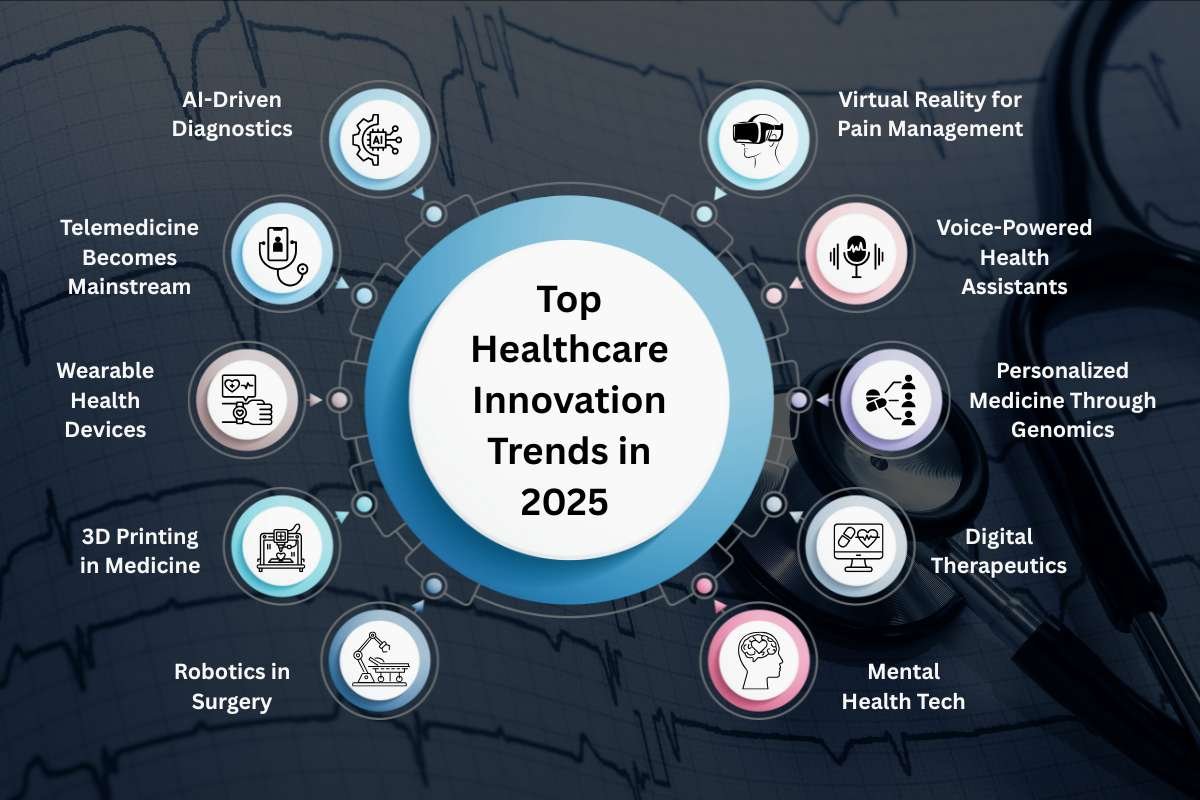In 2025, healthcare innovation will drive smarter, faster, and more human-centered care. This blog explores 10 groundbreaking trends transforming medicine delivery—from AI diagnostics to virtual reality pain therapy. Discover the future of healthcare that’s already here.
What if getting a check-up no longer meant rearranging your day, sitting in a waiting room, or flipping through outdated magazines? In 2025, this is no longer a what-if. With a smartphone, you can connect with doctors, receive prescriptions, and track your health from home.
We live in a time when smartwatches monitor heart rhythms, AI catches diseases earlier than doctors can, and robotic arms assist in surgery with microscopic precision. These changes are not just curious thoughts about the future but a reality that transformed the world.
This transformation is part of a decisive shift known as healthcare innovation. It’s not just about gadgets; it’s about rethinking how healthcare is delivered, accessed, and experienced. As diseases evolve and global needs change, healthcare systems are being reimagined to provide faster, fairer, and more effective care. This article will look into the breakthroughs of 2025 and the path that led us here.
What Is Healthcare Innovation?

It refers to new technologies and methods that improve how healthcare is delivered and experienced. This can include tools that help doctors diagnose illnesses more accurately, systems that make hospitals run more efficiently, or even new ways to reach patients in remote areas. Innovation isn’t always flashy. Sometimes, it’s as simple as improving communication between doctor and patient. Other times, it’s a bold leap forward, like using artificial intelligence to predict heart disease or 3D printing a customized prosthetic limb. What makes innovation in healthcare unique is that it directly impacts lives—helping people heal faster, live longer, and stay healthier.
Top Healthcare Innovation Trends in 2025

1. AI-Driven Diagnostics
AI is transforming how doctors detect diseases. Advanced algorithms can now read scans like X-rays and MRIs with amazing accuracy, often spotting problems earlier than humans can. They even help predict outbreaks and flag health risks before symptoms appear, giving doctors a head start in saving lives.
2. Telemedicine Becomes Mainstream
What started as a pandemic solution is now a pillar of healthcare. Telemedicine lets patients consult doctors from anywhere, saving time and increasing access, especially in rural or underserved areas. In 2025, this isn’t just video calls—it includes remote monitoring, virtual rehabilitation, and even AI-powered health assistants.
3. Wearable Health Devices
Smartwatches and fitness bands now do more than count steps. They track blood pressure, oxygen levels, heart rhythms, and sleep patterns in real-time. These wearables send alerts for irregularities and give users more control over their health, preventing issues before they become emergencies.
4. 3D Printing in Medicine
From dental implants to bone scaffolds, 3D printing is reshaping personalized medicine. This technology reduces costs and speeds up production for patient-specific devices. In 2025, 3D-printed tissues for research and even organ models for surgery planning are becoming standard tools in top hospitals.
5. Robotics in Surgery
Robot-assisted surgery allows for precise, minimally invasive procedures. These robots offer greater control, reduce risk, and help patients recover faster. In 2025, smaller and smarter robots will be making complex surgeries safer and more accessible—even in lower-income countries.
6. Mental Health Tech
Apps and platforms focused on mental well-being have surged. From AI therapy bots to virtual reality treatments for PTSD and anxiety, mental health support is becoming more personalized and stigma-free, thanks to healthcare innovation.
7. Digital Therapeutics
Digital therapeutics (DTx) are software-based interventions that treat diseases and manage conditions using evidence-backed digital tools. These apps go beyond simple health tracking; they’re FDA-approved treatments for issues like diabetes, ADHD, insomnia, and even substance use disorders. Patients use them alongside or instead of traditional medication, making treatment more accessible and tailored to daily life.
8. Personalized Medicine Through Genomics
Thanks to advancements in genetic testing, treatments are becoming increasingly personalized. In 2025, doctors can use a patient’s DNA to predict which medications will work best or avoid those that may cause side effects. Genomic data helps prevent diseases before they start and guides cancer therapies with pinpoint accuracy.
9. Voice-Powered Health Assistants
Voice tech is becoming a trusted tool in everyday healthcare. Smart speakers can now remind patients to take medication, book appointments, and answer common health questions. For the elderly or visually impaired, this hands-free support brings comfort and independence, showing how healthcare innovation can make everyday life healthier and easier.
10. Virtual Reality for Pain Management
Hospitals are now using virtual reality (VR) to help patients manage pain and anxiety during procedures. Instead of relying only on medication, patients are immersed in calming, interactive environments. VR reduces stress and helps distract from discomfort, proving that healing can be both high-tech and deeply human.
The Impact of Innovation

The results of these breakthroughs are impressive. Patients with chronic illnesses are managing their conditions better with remote monitoring. Surgeons are achieving better results with robotic help. Rural communities now have better access to care through telehealth.
One of the best examples comes from a hospital in India that uses AI to predict heart disease in patients with limited access to specialists. By catching symptoms early, lives are being saved that otherwise may have been lost due to delayed care. This is the power of healthcare innovation when it’s applied with empathy and purpose.
Challenges Still Ahead
Despite the progress made, challenges persist. Data security remains a significant concern. As more patient information transitions online, safeguarding it from cyberattacks becomes essential. Furthermore, not everyone has access to high-speed internet or smartphones, resulting in a digital divide. Healthcare providers also need training to use these new tools effectively. If doctors and nurses aren’t confident using AI systems or digital platforms, the technology won’t fulfill its promise.
Lastly, regulation and reimbursement often fall behind innovation. For instance, not all insurance plans cover telehealth yet, despite its established benefits.
What Does The Future Hold?
Innovation is a subject of evolution. In the coming years, we can expect even more personalized treatments, gene-based therapies, and smart hospitals that run almost like tech startups. But the heart of innovation remains the same: solving real problems for real people. Whether it’s a smartwatch detecting atrial fibrillation or a robot assisting a surgeon in a life-saving operation, healthcare innovation is making care better, more innovative, and more human.
Conclusion
Look, by 2025, healthcare innovation isn’t just a buzzword; it’s a full-on shift. It empowers patients, supports doctors, and opens doors for those once left behind. But to keep moving forward, innovation must stay grounded in compassion, accessibility, and safety. As we look ahead, the question isn’t whether healthcare will keep changing. It’s how we’ll make sure those changes benefit everyone, everywhere.









